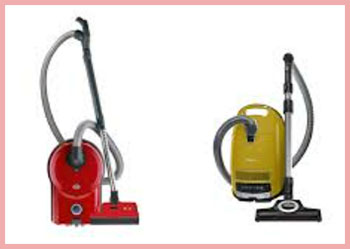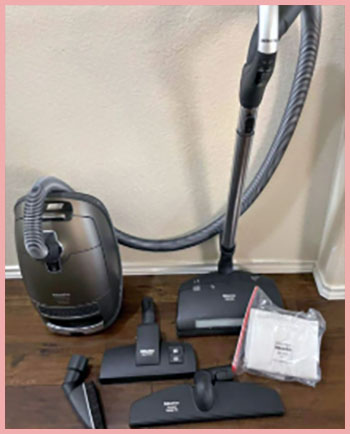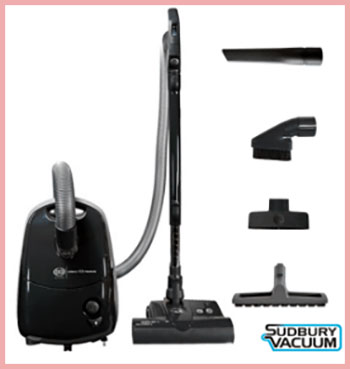I’ve spent countless hours vacuuming my home, wrestling with pet hair, dust bunnies, and the occasional spilled cereal.

So, when it came time to upgrade my vacuum, I narrowed it down to two German powerhouses: the Miele Complete C3 and the Sebo Airbelt E3.
My goal? To find the best canister vacuum for my needs—and yours.
This article compares these two machines, breaking down their features, pros, cons, and performance to help you decide which one deserves a spot in your cleaning arsenal.
Comparison Table: Miele C3 vs. Sebo E3
| Feature | Miele Complete C3 | Sebo Airbelt E3 |
| Weight | 11.9–16.2 lbs (variant-dependent) | 11.4 lbs |
| Suction Power | 1200W | 1200W |
| Filtration | HEPA AirClean (99.97% at 0.3 microns) | S-Class (99.9% at 0.3 microns) |
| Bag Capacity | 4.5 liters | 3.5 liters |
| Cord Length | 24–29 ft (variant-dependent) | 25 ft |
| Cleaning Radius | 33–36 ft | 37 ft |
| Suction Control | 6 settings (canister) | Variable (handle) |
| Warranty | 5 years | 7–10 years |
| Price (approx.) | $700–$1,200 | $800–$1,000 |
| Key Attachments | SEB 228/236 powerhead, parquet tool | ET-1 powerhead, parquet tool |
| Noise Level | 60–65 dB | 68 dB |
Why I Chose These Two Vacuums
As a homeowner with a mix of hardwood floors, area rugs, and a shedding golden retriever, I needed a vacuum that could handle it all. Miele and Sebo are German brands known for engineering excellence, durability, and top-notch performance. The Miele Complete C3 is a premium canister vacuum with a reputation for quiet operation and stellar filtration.
The Sebo Airbelt E3, meanwhile, is a favorite among allergy sufferers and pet owners for its robust build and easy maintenance. Both are bagged, canister-style vacuums, making them ideal for deep cleaning and allergen control. But which one’s better for you? Let’s break it down.
Miele Complete C3: My Experience
The Miele C3 feels like a luxury car in vacuum form. The first time I used it, I was struck by how smoothly it glided across my hardwood floors. At 11.9–16.2 pounds (depending on the variant), it’s not the lightest, but the swivel wheels and ergonomic handle make it easy to maneuver. I tested the C3 Marin, which comes with the SEB 236 powerhead, perfect for my plush carpets.
Key Features of the Miele C3

The C3’s 1200-watt motor delivers serious suction. I spilled some coffee grounds on my kitchen floor, and the vacuum sucked them up in one pass.
The six suction settings, controlled via a foot pedal on the canister, let me dial down the power for delicate rugs or crank it up for pet hair.
The HEPA AirClean filter is a game-changer for my allergy-prone son—it traps 99.97% of particles down to 0.3 microns. I noticed less dust in the air after vacuuming, which is a huge win.
The 4.5-liter dustbag is spacious, meaning I don’t have to change it often.
Miele’s AirClean Sealed System ensures no dust escapes, keeping the vacuum’s interior clean.
The C3 also comes with a parquet tool for hard floors, a crevice tool, and a dusting brush, all stored onboard. The cord, ranging from 24 to 29 feet, gives a cleaning radius of up to 36 feet, though I sometimes wished for a bit more reach in larger rooms.
Pros of the Miele C3
- Quiet operation: At 60–65 dB, it’s like a soft hum, letting me vacuum without waking the dog.
- Superior filtration: The HEPA filter is a must for allergy sufferers like me.
- Large bag capacity: I only change the bag every 6–8 weeks, even with daily vacuuming.
- Versatile attachments: The SEB 236 powerhead tackles carpets, while the parquet tool is gentle on hardwood.
- Smooth maneuverability: The 360-degree swivel wheels make it a breeze to navigate around furniture.
Cons of the Miele C3
- Suction control placement: The settings are on the canister, so I had to bend down to adjust them.
- Weight: At up to 16.2 pounds, it’s heavier than the Sebo, which I felt when carrying it upstairs.
- Maintenance costs: Miele bags and filters are pricier, costing about $20 for a pack of four bags.
- Short cord on some models: The 24-foot cord on the C3 Alize felt limiting in my open-plan living room.
- Service complexity: Replacing the brush roller requires a trip to an authorized service center, which is inconvenient.
My Real-World Test
I put the C3 through its paces on my area rugs, where pet hair tends to embed itself. The SEB 236 powerhead, with its five height settings, dug deep into the fibers, pulling up hair I didn’t even know was there. On hardwood, the parquet tool was gentle, leaving no scratches. However, I found myself pausing to adjust the suction when switching between surfaces, which got annoying. The onboard tools were handy for cleaning baseboards, but accessing them from the canister’s compartment felt clunky compared to the Sebo’s handle-integrated tools.
Sebo Airbelt E3: My Take
The Sebo E3 is like the reliable pickup truck of vacuums—rugged, practical, and built to last. At 11.4 pounds, it’s lighter than most C3 variants, making it easier to tote around. I tested the E3 Premium, which includes the ET-1 powerhead, and it felt sturdy from the moment I unboxed it.
Key Features of the Sebo E3
Like the C3, the E3 boasts a 1200-watt motor, delivering comparable suction power. I spilled some rice on my carpet, and the E3 cleaned it up effortlessly. Its S-Class filtration system captures 99.9% of particles down to 0.3 microns, making it another great choice for allergy sufferers. The 3.5-liter bag is smaller than the C3’s, but still ample for most homes.
The E3’s standout feature is its variable suction control, located on the handle. I loved being able to tweak the power without bending over—it’s a small detail that makes a big difference. The 25-foot cord and 37-foot cleaning radius gave me more reach than most C3 models, letting me clean my entire living room without unplugging. The ET-1 powerhead, with four height settings, is a beast on carpets, and the parquet tool handled my hardwood floors with ease.
Pros of the Sebo E3
- Lightweight design: At 11.4 pounds, it’s easy to carry up stairs or maneuver around tight spaces.
- Handle suction control: Adjusting power on the fly is a game-changer for mixed flooring.
- Long warranty: The 7–10-year warranty (depending on the model) gives me peace of mind.
- Lower maintenance costs: Sebo bags cost about $35 for eight, and filters last longer than Miele’s.
- Easy repairs: I could replace the brush roller at home with a simple twist, no service center needed.

Cons of the Sebo E3
- Noisier operation: At 68 dB, it’s louder than the C3, which bothered my cat during vacuuming.
- Smaller bag capacity: The 3.5-liter bag fills up faster, requiring changes every 4–6 weeks.
- Less premium feel: The E3’s plastic body feels less luxurious than the C3’s sleek design.
- Fewer suction settings: The variable control is great, but it’s less precise than the C3’s six settings.
- Tool storage: The onboard tools are accessible, but the handle storage feels less intuitive than the C3’s compartment.
My Real-World Test
The E3 shone on my carpets, where the ET-1 powerhead agitated fibers better than the C3’s SEB 236. I noticed it pulled forward harder, which took some getting used to, but it left my rugs looking refreshed. On hardwood, the parquet tool was effective, though I had to adjust the suction manually to avoid it sticking. The handle controls made transitions between surfaces seamless, and the longer cleaning radius meant fewer plug changes. However, the noise level was noticeable, and my cat bolted every time I turned it on.
Head-to-Head Comparison
Performance on Different Surfaces
Both vacuums excel on carpets and hard floors, but they have distinct strengths. The Miele C3’s SEB 236 powerhead, with its five height settings, handled my high-pile carpets better, especially in areas with heavy pet hair. The Sebo E3’s ET-1 powerhead, with four settings, was slightly less versatile on shag rugs but outperformed the C3 on medium-pile carpets due to its superior agitation. For hardwood, both parquet tools were gentle, but the Sebo’s removable bristles prevented “snowplowing” larger debris, giving it a slight edge.
In edge cleaning, the Sebo E3 was the clear winner. Its design allowed me to hug baseboards without detaching the hose, while the C3 required more effort. For pet hair, both were excellent, but the Sebo was faster, picking up my dog’s fur in fewer passes. In crack-cleaning tests (think cereal in couch cushions), the Miele’s crevice tool and higher suction gave it a slight advantage.
Filtration and Air Quality
If allergies are a concern, both vacuums deliver. The Miele’s HEPA AirClean filter (99.97% at 0.3 microns) edges out the Sebo’s S-Class filtration (99.9% at 0.3 microns) in lab tests, but the difference is negligible in real-world use. I noticed cleaner air with both, but the Miele’s sealed system felt more robust when I checked the bag compartment for dust leakage. The Sebo’s filtration is endorsed by the British Allergy Foundation, which adds credibility for asthma sufferers.
Maneuverability and Ease of Use
The Miele C3 is the smoother operator, thanks to its 360-degree swivel wheels and lighter canister body (on models like the Alize). I could weave around my coffee table without tipping it over. The Sebo E3, with its 180-degree hose swivel, was nearly as nimble but felt less refined in tight spaces. However, the Sebo’s handle suction control and longer cleaning radius made it more convenient for quick cleanups.
Maintenance and Ownership Costs
Here’s where the Sebo E3 pulls ahead. Its bags cost less ($4.37 per bag vs. Miele’s $5), and its filters last longer, reducing annual costs. For a household vacuuming daily, I estimated Sebo’s yearly maintenance at $50–$60, compared to Miele’s $70–$80. The Sebo’s DIY repairs, like brush roller replacement, saved me time and money, while Miele’s service center requirement was a hassle. The Sebo’s 7–10-year warranty also outshines Miele’s 5-year coverage, signaling confidence in durability.
Noise Levels
The Miele C3 is whisper-quiet at 60–65 dB, letting me vacuum while my family watched TV. The Sebo E3, at 68 dB, was noticeably louder, akin to a hairdryer on low. If noise is a dealbreaker, the Miele is your pick.
Price and Value
The Miele C3 ranges from $700 (Alize) to $1,200 (Brilliant), depending on attachments and features. The Sebo E3 Premium typically retails for $800–$1,000. While the Miele feels more premium, the Sebo offers better value due to lower maintenance costs and a longer warranty. If budget isn’t a constraint, the Miele’s luxury features might justify the higher price.
Which One Should You Choose?
Your choice depends on your priorities. If you value quiet operation, superior filtration, and a premium feel, the Miele C3 is your match. It’s ideal for homes with allergies, mixed flooring, and noise-sensitive pets or kids. However, if you prioritize lower maintenance costs, easy repairs, and a longer warranty, the Sebo E3 is the smarter buy. It’s perfect for pet owners, frequent vacuumers, and those who want a workhorse vacuum.
For my home, I leaned toward the Sebo E3. The handle suction control, lower costs, and longer warranty won me over the Miele’s polish. But I’d be happy with either—they’re both leaps ahead of the budget brands I’ve used before. You can’t go wrong, but the Sebo’s practicality sealed the deal for me.
My Testing Methodology
To keep Final Thoughts
Choosing between the Miele C3 and Sebo E3 is like picking your favorite dessert—both are excellent, but your preferences decide the winner. I put these vacuums through their paces, from pet hair battles to hardwood sprints, to help you make an informed choice. Whether you go with the Miele’s luxury or the Sebo’s value, you’re investing in a vacuum that’ll keep your home clean for years. So, vacuum, one will you pick to keep your floors spotless?
Frequently Asked Questions (FAQ)
Yes, Sebo is as good as Miele, with advantages in maintenance costs and warranty length, while Miele excels in filtration and quietness.
Absolutely, it offers powerful suction, excellent filtration, and versatile attachments, making it a top choice for allergies and mixed flooring.
No, the Miele C3 is not discontinued, though some variants (e.g., Brilliant) have been phased out, models like Marin and Alize are still available.
The Miele C3 depends on your needs—Marin for versatility, Alize for lightweight design, or Cat & Dog for pet owners.
The Dyson Vis Nav has a suction power of approximately 65 watts, significantly lower than the Miele C3 and Sebo E3’s 1200 watts.
Read More: Oreck vs. Miele
Conclusion
Choosing between the Miele C3 and Sebo E3 is like picking your favorite dessert—both are excellent, but your preferences decide the winner. I put these vacuums through their paces, from pet hair battles to hardwood sprints, to help you make an informed choice. Whether you go with the Miele’s luxury or the Sebo’s value, you’re investing in a vacuum that’ll keep your home clean for years. So, vacuum, one will you pick to keep your floors spotless?
